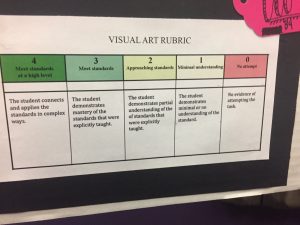Rubrics
 Mohammed, middle school social studies teacher
Mohammed, middle school social studies teacher
“Rubrics were essential. I’ve realized that the expectation isn’t always clear for students. I might know exactly what I want the students to do, but somewhere along the line, they didn’t get it. Or someone wasn’t paying attention. Or they’re 12, and they just weren’t listening. Or they listened and they completely forgot. There’s a lot of reasons why they’re confused as to what they’re supposed to be doing. It was always frustrating to me.The rubrics help to solidify what the expectation is. And you have it, it’s in front of you, and now there’s no excuse. Exactly what they needed to do was right in front of them. When they would say, ‘Okay, I’m done.’ I would ask them, ‘Did you check it against the rubric?’ Once they started doing that, it just made everything a lot easier.
“Also, when I’m grading with rubrics, it takes away as much of the bias as you can. When you’re looking at papers and it’s like, ‘Oh, well, this kid, he tried really hard,’ you can become lenient with grades and you’re not actually grading what’s in front of you. The rubric helps me, as a teacher, to not do that. I’m looking at the final product and I’m comparing it to rubrics, so the grading becomes more consistent. If I just look directly at the rubric and grade it, it doesn’t matter who it’s from. It provides, in my experience, the most objective grading. If students turn something in and they don’t get a good grade, it’s very easy to say, ‘Look at the rubric and look at what you did and tell me what’s wrong.’ Rubrics reinforce the concept that all students can achieve.”
Bernardo, middle school humanities teacher
“I’ve had students self-grade their projects with rubrics and turn it in with their assignment. I was hoping that I would see an improvement on the projects. What I’ve noticed is that since I’ve done that the projects are almost all A’s and B’s. The surprising thing was that I thought it would improve a little bit. I did not think it would be that drastic.
“The other thing that I found that was super surprising was that students asked me, ‘Is that going to be our grade or are you still going to grade it?’ I just told them, ‘We’ll see. I haven’t decided yet.’ I thought that knowing that that I might use their grades, they were going to inflate their grades, but they didn’t. If anything, they were mostly spot on. If it was off at all, it was probably them grading themselves harder than I would grade them.
“The next step for me is not allowing students to turn in a project unless it’s earned a certain score on the rubric, or having a peer score it, and them having a conversation with the peer. Maybe the peers would tell them or help them recognize, ‘Oh, there’s something I need to do,’ so they can still do that before it gets turned in.
